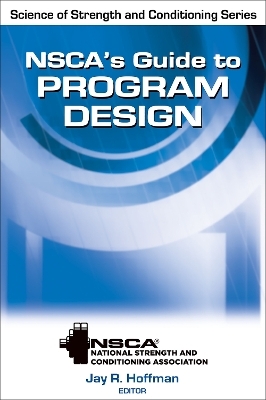
NSCA's Guide to Program Design
Human Kinetics (Verlag)
978-0-7360-8402-4 (ISBN)
Straightforward and accessible, NSCA’s Guide to Program Design presents a detailed examination of considerations and challenges in developing a program for each key fitness component and fitness performance goal. Editor Jay Hoffman and his team of contributors have assembled an exceptional reference for practicing professionals and a valuable educational resource for new professionals and students preparing for certification.
This authoritative text moves beyond the simple template presentation of program design to help readers grasp the reasons and procedures for sequencing training in a safe, sport-specific manner. The text offers 20 tables that are sample workouts or training plans for athletes in a variety of sports, technique photos and instructions for select drills, and a sample annual training plan that shows how to assemble all the pieces previously presented. Plus, extensive references offer starting points for continued study and professional enrichment.
NSCA’s Guide to Program Design progresses sequentially through the program design process. It begins by examining the athlete needs assessment process as well as performance testing considerations and selection. Next, performance-related information on both dynamic warm-up and static stretching is discussed and dynamic warm-up protocols and exercises are presented. Then it reveals an in-depth by-chapter look at program design for resistance, power, anaerobic, endurance, agility, speed, and balance and stability training. For each, considerations and adaptations are examined, strategies and methods are discussed, and evidence-based information on program development is presented. The final two chapters help you put it all together with a discussion of training integration, periodization, and implementation. In addition, a sample annual training plan illustrates how to integrate each of the key fitness components into a cohesive yearlong program. As a bonus, a sample annual training plan is provided on our website so you can create your own training plans.
The fitness, safety, and performance of athletes reflect the importance of continued education in the science of strength and conditioning. NSCA’s Guide to Program Design helps bridge the gap between scientist and practitioner by providing coaches and other strength and conditioning professionals with evidence-based information and applications. Sharing the latest in proven research, NSCA’s Guide to Program Design helps readers remain on the cutting edge of athletic performance.
NSCA’s Guide to Program Design is part of the Science of Strength and Conditioning series. Developed with the expertise of the National Strength and Conditioning Association (NSCA), this series of texts provides the guidelines for converting scientific research into practical application. The series covers topics such as tests and assessments, program design, and nutrition.
Earn continuing education credits/units! A continuing education course and exam that uses this book is also available. It may be purchased separately or as part of a package that includes all the course materials and exam.
Founded in 1978, the National Strength and Conditioning Association (NSCA) is an international nonprofit educational association with members in more than 56 countries. Drawing on its vast network of members, the NSCA develops and presents the most advanced information regarding strength training and conditioning practices, injury prevention, and research findings. Unlike any other organization, the NSCA brings together a diverse group of professionals from the sport science, athletic, allied health, and fitness industries. By working to find practical applications for new research findings in the strength and conditioning field, the association fosters the development of strength training and conditioning as a discipline and as a profession. Jay Hoffman, PhD, is a professor of exercise science at the University of Central Florida and coordinator of their sport and exercise science program. Long recognized as an expert in the field of exercise physiology, Hoffman has more than 150 publications to his credit in refereed journals, book chapters, and books, and he has lectured at more than 300 national and international conferences and meetings. He also has more than 17 years of experience coaching at the collegiate and professional levels. This combination of the practical and the theoretical provides him with a unique perspective on writing for both coaches and academic faculty. Hoffman was elected president of the National Strength and Conditioning Association in 2009. He was awarded the 2005 Outstanding Kinesiological Professional Award by the Neag School of Education at the University of Connecticut and the 2007 Outstanding Sport Scientist of the Year by the National Strength and Conditioning Association. He also was awarded the 2000 Outstanding Junior Investigator Award by the NSCA. He is a fellow of the American College of Sports Medicine and serves on the board of directors of the USA Bobsled and Skeleton Federation. He is the author of Physiological Aspects of Sport Training and Performance (Human Kinetics, 2002) and Norms for Fitness, Performance, and Health (Human Kinetics, 2006).
Chapter 1. Athlete Needs Analysis
William J. Kraemer, PhD, Brett A. Comstock, MA, James E. Clark, MS, and Courtenay Dunn-Lewis, MA
Metabolic Demands of the Sport
Biomechanical Demands of the Sport
Injury Risks of the Sport
Integrating the Needs Analysis
Chapter 2. Athlete Testing and Program Evaluation
Jay R. Hoffman, PhD
Factors That Affect Performance Testing
Test Selection
Practical Considerations for Test Administration
Tests for Needs Assessment and Program Evaluation
Chapter 3. Dynamic Warm-Up
Avery D. Faigenbaum, EdD
Static Stretching and Performance
Dynamic Warm-Up and Performance
Developing a Dynamic Warm-Up Protocol
Dynamic Warm-Up Exercises
Chapter 4. Resistance Training
Nicholas A. Ratamess, PhD
Adaptations to Resistance Training
Customizing Resistance Training Programs
Resistance Training Program Variables
Chapter 5. Power Training
Robert U. Newton, PhD, Prue Cormie, PhD, and William J. Kraemer, PhD
Factors Contributing to Power Output
Targeting Power Development
Training Methods for Power Development
Selecting Load and Velocity for Power Development
Chapter 6. Anaerobic Conditioning
Jay R. Hoffman, PhD
Physiological Adaptations From Anaerobic Conditioning Programs
Developing Anaerobic Conditioning Programs
Anaerobic Conditioning Exercises
Chapter 7. Endurance Training
Joel T. Cramer, PhD, and Abbie E. Smith, PhD
Factors in Aerobic Endurance Performance
Aerobic Endurance Training Variables
Aerobic Endurance Training Strategies
Periodization for Aerobic Endurance Training
Chapter 8. Agility Training
Lee E. Brown, EdD, and Andy V. Khamoui, MS
Factors in Agility Performance
Assessing Agility
Training for Agility
Agility Program Design
Chapter 9. Speed Training
Jay R. Hoffman, PhD, and John Graham, MS
Factors in Speed Performance
Sprinting Mechanics and Technique
Speed Program Design
Chapter 10. Balance and Stability Training
Nejc Sarabon, PhD
Program Planning and Periodization
Safe Progression for Balance Exercises
Stability Training for Joint Systems
Chapter 11. Training Integration and Periodization
G. Gregory Haff, PhD, and Erin E. Haff, MA
General Principles of Periodization
Training Periods
Sequencing and Integration of the Training Process
Practical Guidelines
Chapter 12. Training Program Implementation
Jay R. Hoffman, PhD, Lee E. Brown, PhD, and Abbie E. Smith, PhD
Workout Sessions
Off-Season Training
Competitive Season
Considerations for Endurance Athletes
Program Evaluation
| Reihe/Serie | NSCA Science of Strength & Conditioning |
|---|---|
| Verlagsort | Champaign, IL |
| Sprache | englisch |
| Maße | 178 x 254 mm |
| Gewicht | 862 g |
| Themenwelt | Sachbuch/Ratgeber ► Gesundheit / Leben / Psychologie |
| Schulbuch / Wörterbuch | |
| Sozialwissenschaften ► Pädagogik | |
| ISBN-10 | 0-7360-8402-9 / 0736084029 |
| ISBN-13 | 978-0-7360-8402-4 / 9780736084024 |
| Zustand | Neuware |
| Informationen gemäß Produktsicherheitsverordnung (GPSR) | |
| Haben Sie eine Frage zum Produkt? |
aus dem Bereich



